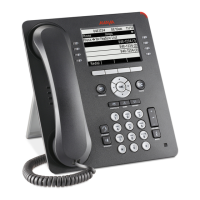8. While the IP telephone connects to the HTTP server, the telephone displays one of
the following messages :
HTTP: n ipadd
or HTTP: n ipadd * to program
where n is the number of the IP Address obtained from the HTTP server and ipadd
is the IP Address.
Important:
Pressing * at this time invokes the Craft Access entry procedure to allow manual
settings. For information, see Using Local Administrative (Craft) Options on
page 33
9. When connected, the telephone looks for an upgrade script file.
10. The HTTP server sends and identifies an upgrade script.
The GET message might have to be sent several times. Each time the GET
message is sent, all IP telephones display the following message: HTTP: n uri
For HTTP, n is the number of HTTP requests made by the telephone and uri is the
URI for the current HTTP request.
Note:
The SIG parameter value determines the signaling protocol (H.323, SIP, both)
and is used to determine the proper upgrade file that is downloaded. If the SIG
parameter was manually set using the local administrative (Craft) SIG procedure,
that value has precedence over a SIG setting in a configuration file. A change in
the SIG value may require a reset so that a new or different upgrade file can be
downloaded to the phone.
11. While the upgrade script file is being downloaded, all IP telephones display the
following message: HTTP: n sc etag
where n is the number of the IP Address obtained from the HTTP server, sc is the
status code of the HTTP response and etag is the value of the ETag header.
12. When the telephone determines that the application file received is valid, the
following message displays: File Obtained; please wait...... s secs
where s is the number of seconds that elapse while non-volatile memory is
erased.
13. While the application file is saved in flash memory, all IP telephones display the
following message: Saving to flash 1% 1 secs
with the percentage of the file and the number of elapsed seconds incremented as
the application file is stored in flash memory.
14. The telephone contacts the Avaya Media Server and attempts to log in.
Installing the Deskphone
30 H.323 Installation & Maintenance Guide R6.1 May 2011

